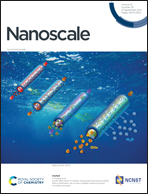Phase transition and topological transistors based on monolayer Na3Bi nanoribbons†
Abstract
Recently, a topological-to-trivial insulator quantum-phase transition induced by an electric field has been experimentally reported in monolayer (ML) and bilayer (BL) Na3Bi. A narrow ML/BL Na3Bi nanoribbon is necessary to fabricate a high-performance topological transistor. By using the density functional theory method, we found that wider ML Na3Bi nanoribbons (>7 nm) are topological insulators, featured by insulating bulk states and dissipationless metallic edge states. However, a bandgap is opened for extremely narrow ML Na3Bi nanoribbons (<4 nm) due to the quantum confinement effect, and its size increases with the decrease in width. In the topological insulating ML Na3Bi nanoribbons, a bandgap is opened in the metallic edge states under an external displacement electric field, with strength (∼1.0 V Å−1) much smaller than the reopened displacement electric field in ML Na3Bi (3 V Å−1). An ultrashort ML Na3Bi zigzag nanoribbon topological transistor switched by the electrical field was calculated using first-principles quantum transport simulation. It shows an on/off current/conductance ratio of 4–71 and a large on-state current of 1090 μA μm−1. Therefore, a proof of the concept of topological transistors is presented.



 Please wait while we load your content...
Please wait while we load your content...